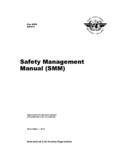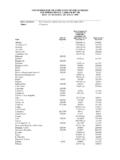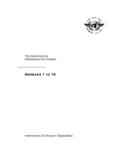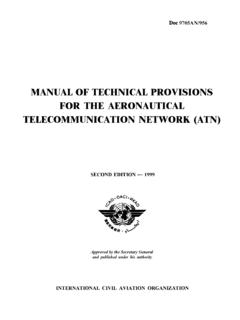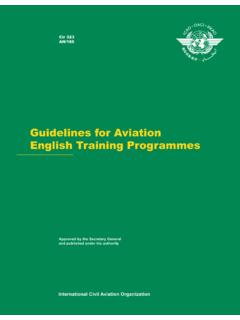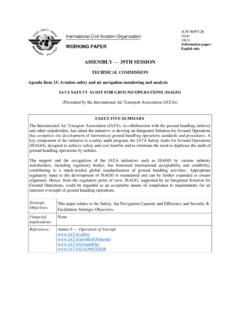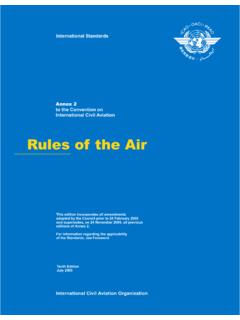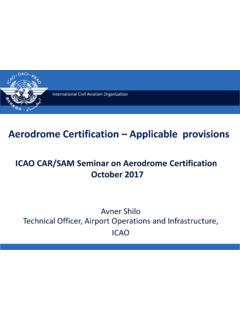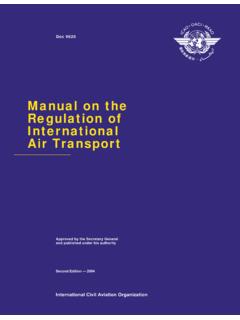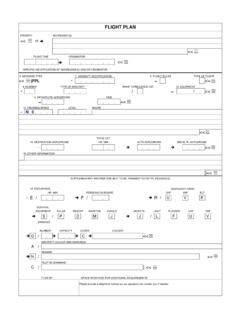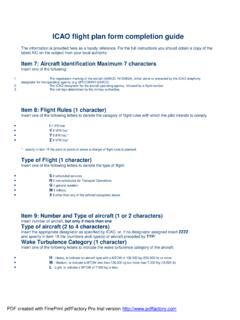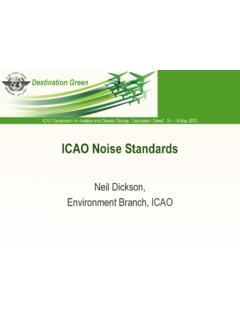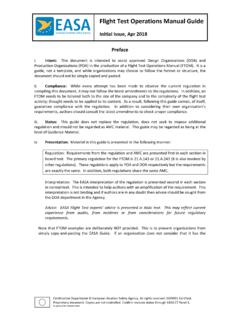Transcription of RNAV to RNP Instrument Approach Chart Depiction - ICAO
1 RNAV to RNP Instrument Approach Chart Depiction Abbas NIKNEJAD Regional Officer, AIM/ATM PBN SG/2 (Sharm El Sheikh, Egypt, 22 - 25 February 2016) OUTLINE Background icao Provisions Naming convention changes Chart Identification PBN Requirement Box Impact of change Change management considerations States Transition Plan Mitigation Process Action by the meeting Appendix A: icao Circular 336; RNAV to RNP charting BACKGROUND The emergence of PBN is having a major impact on all aspects of the aviation industry. However, inconsistencies with the aeronautical charts, the PBN operational approvals and the avionics displays have created confusion for pilots and air traffic controllers.
2 As a result, icao has decided to rationalize the Chart -naming convention in order to remove the inconsistencies and align the aeronautical Approach charts with the PBN operations approval. This will reduce the confusion and provide a simpler and clearer method for procedure naming and a standardized Approach to aeronautical charting. 3 BACKGROUND Currently, the PBN Approach procedure naming convention is not standardized throughout the world and is inconsistent with the PBN navigation specifications. Examples of differing naming conventions used by States include RNAV (GPS) RWY XX, RNAV (GNSS) RWY XX, RNAV (RNP) RWY XX.
3 In reviewing the PBN navigation specifications, it became readily apparent that any Approach using GNSS was in fact an RNP Approach due to the requirement for on-board monitoring and alerting. Consequently, all RNAV (GNSS) Approach procedures are RNP procedures. 4 icao PROVISIONS The amendment 6 to the Procedures for Air Navigation Services Aircraft Operations (PANS-OPS, DOC 8168) (date of applicability 13 November 2014) introduced procedure design criteria and charting requirements to support PBN. The new icao Circular 336 provides guidance to assist States and other stakeholders with the transition from RNAV to RNP Approach Chart identification.
4 This circular provides the necessary guidance to States on how to make that transition. 5 NAMING CONVENTION CHANGES As a transition, until 30 November 2022, Approach charts depicting procedures that meet the RNP APCH navigation specification criteria must include either the term RNP or RNAV (GNSS) in the identification ( RNP RWY 23 or RNAV (GNSS) RWY 23). However, from 1 December 2022, only the term RNP will be permitted. Until 30 November 2022, Approach charts depicting procedures that meet the RNP AR APCH navigation specification criteria must include either the term RNP (AR) or RNAV (RNP) in the identification ( RNAV (RNP) RWY 23).
5 However, from 1 December 2022, only the term RNP (AR) will be permitted. 6 States may decide to go directly from the current naming convention that is used to the final convention 7 EXAMPLES Chart IDENTIFICATION The Chart identification must include the runway identification for straight-in landing (RNP RWY 23) For circling procedure; a letter designator (a, b, c, etc.); example: RNP A When more than one PBN Approach procedure exists for the same runway: RNP Z RWY 23, RNP Y RWY 23 8 Chart IDENTIFICATION PARENTHETICAL SUFFIX (FOR EXCEPTIONAL CONDITIONS) 9 The text in the parenthesis that is part of the procedure identification does not form part of the ATC Clearance.
6 PBN REQUIREMENT BOX When amending/publishing PBN Approach procedures, additional procedure requirements must be provided as Chart notes. PBN items must be separated out and published in a PBN requirements box which includes the identification of the navigation specification used in procedure design and any optional requirements that are not included in the core navigation specification. 10 NEW PBN Chart DESIGNATION (WITH PBN REQUIREMENTS BOX) 11 IM PA C T OF CHANGE Air navigation service providers (ATS) Charting houses/AIS Data Integrators (Jeppesen, Lufthansa system, etc.) Aircraft/Avionic Manufacturers (FMS Databases, etc.)
7 Aircraft operators/Airlines Pilots/Air Traffic Controllers Training Institutes Instrument procedure design organizations State regulators General aviation Airport authorities Military 12 CHANGE MANAGEMENT CONSIDERATIONS 13 No Item Requirement Remarks 1 Chart identification Existing RNAV Approach charts will be renamed to either RNAV(GNSS) RWY XX or directly to RNP RWY XX. States must determine timeline for change and priority. States may amend as part of cyclic maintenance of the procedure. May require changes to automation software. 2 Chart PBN requirements box PBN requirements box has to be added to each PBN Approach Chart , where appropriate.
8 States must determine timeline for change and priority. States may amend as part of cyclic maintenance of the procedure. May require changes to automation software. 3 Pilot training Training information for pilots. May be accomplished through pilot bulletins and reinforced through simulator training sessions. 4 Air traffic control officer (ATCO) training Training information for ATCOs providing airport terminal service. May be accomplished through ATCO bulletin. Training must be conducted prior to the change in the charts for the airports in the terminal area. CHANGE MANAGEMENT CONSIDERATIONS 14 No Item Requirement Remarks 5 Databases Existing databases may have to be amended to reflect new charting change.
9 Database providers will address as required. 6 Procedure design software Procedure design software may have to be amended to reflect charting change. Instrument procedure design organizations will address as required. 7 Charting houses Charts will have to be changed as per numbers 1 and 2. States would issue changes to AIP which would require charting houses to react. This has to be closely coordinated between the State s AIS organization and charting houses. 8 Aircraft flight manual (AFM) The AFM may need to be amended to reflect RNP approval. Air operators to address as required. 9 Operations (OPS) approval Current OPS approval may have to be amended to reflect RNP Approach authorization.
10 Regulator may have to issue clarification. STAT E S TRANSITION PLAN The State transition plan will provide stakeholders with the necessary information including timelines to allow them to prepare for the charting change. The State transition plan will be developed based on the input from the consultation with the stakeholders, while understanding the timelines detailed in Amendment 6 to PANS-OPS, Volume II, Part III, Section 5, Chapter 1 15 MITIGATION PROCESS 16 Description Responsible 1. Preparation Develop an icao circular that addresses both Approach classification and Chart identification to explain that an RNAV with GNSS as sensor meets the RNP requirements and is therefore called an RNP Approach .

